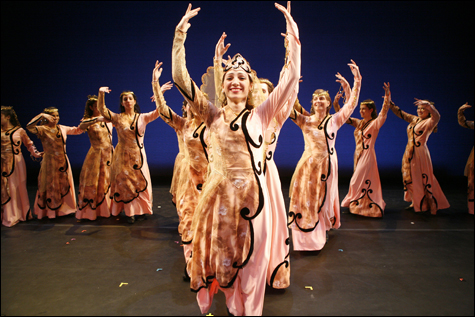
PRESERVING ARMENIAN CULTURE — and evolving out of the performers’ need to testify to a
heritage of sorrow. |
“Out of Darkness” — a one-time performance by Liz Lerman’s Dance Exchange from Washington, DC, and the Boston-based Armenian dance company Sayat Nova — worked under the assumption that remembered pain can be translated into effective stage action. Using this therapeutic process, the groups tried to go beyond healing or even catharsis to probe the politics of identity and the meaning of history.
I’m not sure any new insight was brought to old outrages Saturday night at the Cutler Majestic Theatre, but there was plenty of affirmation for the convinced, and maybe some consciousness raising for those who knew little about the Turkish-Armenian troubles of the early 20th century.
Sayat Nova’s mission is to preserve Armenian culture through dance, and the troupe has recently become involved in the controversy over whether the term “genocide” should be applied to the large-scale slaughter of Armenians in 1915. If this is more than a semantic argument, I think it doesn’t pertain only to the Armenians, or to the Jews of the Holocaust. What about Tibet, Cambodia, Darfur, Kosovo, East Timor — just to name a few scenes of cultural devastation in recent years? For me, the “genocide” question is about confronting the fanaticism that destroys people for being who they are and getting in the way.
The tangled politics of power can’t yield up their complexities in anything as abstract as dance behavior, so storytelling and verbal documentation have become essential to the weightier efforts of community art. The three parts of “Out of Darkness” seem to have evolved out of the performers’ need to testify — in words, mimed scenes, and folkloric dances — to a heritage of sorrow.
In A Child Questions History, which was choreographed by Sayat Nova’s director, Apo Ashjian, dancers step forward and lip-synch recorded family vignettes of abductions, disappearances, and villages overrun while gruesome photographs of victims are projected on the backdrop. For most of the piece, a grandmother sits on the edge of the stage telling stories to a child while the ensemble dances behind them.
Tribal memories thread through these folk dances set to recorded ethno-pop music. Four big bozos in red fezzes strut into the gently swaying lines and circles of women, the stepping grapevine formations of men. They carry one woman off. The dancing continues.
In A Prologue of Pictures, folk dances are lightly inflected to suggest women’s sadness and parting, militant calisthenics for the men. Lines of men and women link up, separate. The 40-member ensemble surmounts everything with a smily, socko chorus-line closer, joined by a few Dance Exchangers. This piece was collaboratively choreographed by Ashjian and Dance Exchange producing artistic director Peter DiMuro and dancer Sarah Strassfeld.
Liz Lerman’s piece, Small Dances About Big Ideas, was created for a prestigious 2005 conference at Harvard about the Nürnberg trials of Nazi leaders. An ambitious series of scenes evoked the human consequences of war’s impersonal machinations. Extremely long and talky, the piece avoided pleasurable displays of dancing, relying instead on ritualized gestures and economical group patterns. Peter DiMuro played a self-described “translator” offering homilies and simulated thoughtfulness. A jury assembles before a crazed judge. A frenzied rape victim attacks the judge, a man clamors for attention behind a wall of people, a possible master and slave end up in a desperate embrace.
At some point, the lights were turned on and the audience was encouraged to get into a discussion about genocide. DiMuro then processed some of the comments into a sequence of gestures we were all supposed to execute, imprinting our thoughts or sending our memories out to the stars. Some people get into this sort of thing. I thought it embarrassing in the 1970s, and I still do.
Whatever you name the crime or whoever you blame it on, ethnic erasure haunts those who’ve been touched by it. You can’t make it all better with a kiss or a song, but maybe it hurts less.